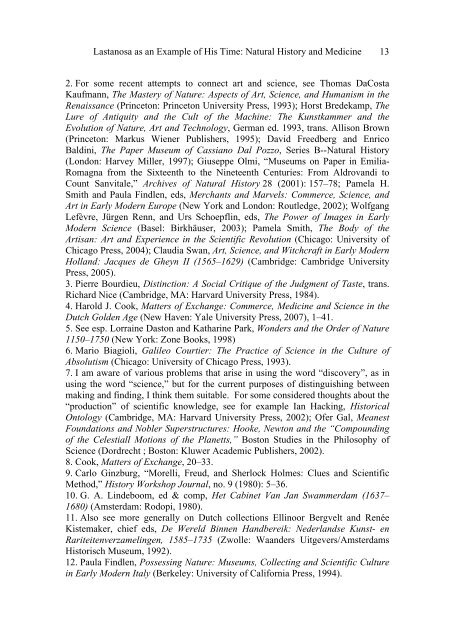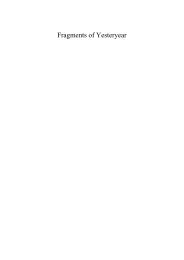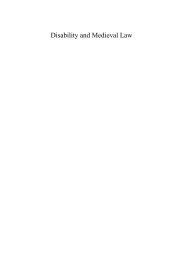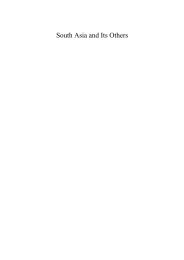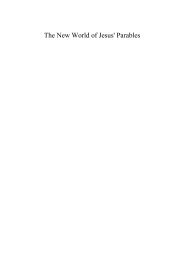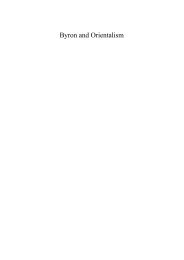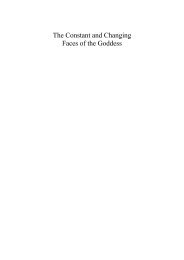The Gentleman, the Virtuoso, the Inquirer - Cambridge Scholars ...
The Gentleman, the Virtuoso, the Inquirer - Cambridge Scholars ...
The Gentleman, the Virtuoso, the Inquirer - Cambridge Scholars ...
You also want an ePaper? Increase the reach of your titles
YUMPU automatically turns print PDFs into web optimized ePapers that Google loves.
Lastanosa as an Example of His Time: Natural History and Medicine<br />
2. For some recent attempts to connect art and science, see Thomas DaCosta<br />
Kaufmann, <strong>The</strong> Mastery of Nature: Aspects of Art, Science, and Humanism in <strong>the</strong><br />
Renaissance (Princeton: Princeton University Press, 1993); Horst Bredekamp, <strong>The</strong><br />
Lure of Antiquity and <strong>the</strong> Cult of <strong>the</strong> Machine: <strong>The</strong> Kunstkammer and <strong>the</strong><br />
Evolution of Nature, Art and Technology, German ed. 1993, trans. Allison Brown<br />
(Princeton: Markus Wiener Publishers, 1995); David Freedberg and Enrico<br />
Baldini, <strong>The</strong> Paper Museum of Cassiano Dal Pozzo, Series B--Natural History<br />
(London: Harvey Miller, 1997); Giuseppe Olmi, “Museums on Paper in Emilia-<br />
Romagna from <strong>the</strong> Sixteenth to <strong>the</strong> Nineteenth Centuries: From Aldrovandi to<br />
Count Sanvitale,” Archives of Natural History 28 (2001): 157–78; Pamela H.<br />
Smith and Paula Findlen, eds, Merchants and Marvels: Commerce, Science, and<br />
Art in Early Modern Europe (New York and London: Routledge, 2002); Wolfgang<br />
Lefèvre, Jürgen Renn, and Urs Schoepflin, eds, <strong>The</strong> Power of Images in Early<br />
Modern Science (Basel: Birkhäuser, 2003); Pamela Smith, <strong>The</strong> Body of <strong>the</strong><br />
Artisan: Art and Experience in <strong>the</strong> Scientific Revolution (Chicago: University of<br />
Chicago Press, 2004); Claudia Swan, Art, Science, and Witchcraft in Early Modern<br />
Holland: Jacques de Gheyn II (1565–1629) (<strong>Cambridge</strong>: <strong>Cambridge</strong> University<br />
Press, 2005).<br />
3. Pierre Bourdieu, Distinction: A Social Critique of <strong>the</strong> Judgment of Taste, trans.<br />
Richard Nice (<strong>Cambridge</strong>, MA: Harvard University Press, 1984).<br />
4. Harold J. Cook, Matters of Exchange: Commerce, Medicine and Science in <strong>the</strong><br />
Dutch Golden Age (New Haven: Yale University Press, 2007), 1–41.<br />
5. See esp. Lorraine Daston and Katharine Park, Wonders and <strong>the</strong> Order of Nature<br />
1150–1750 (New York: Zone Books, 1998)<br />
6. Mario Biagioli, Galileo Courtier: <strong>The</strong> Practice of Science in <strong>the</strong> Culture of<br />
Absolutism (Chicago: University of Chicago Press, 1993).<br />
7. I am aware of various problems that arise in using <strong>the</strong> word “discovery”, as in<br />
using <strong>the</strong> word “science,” but for <strong>the</strong> current purposes of distinguishing between<br />
making and finding, I think <strong>the</strong>m suitable. For some considered thoughts about <strong>the</strong><br />
“production” of scientific knowledge, see for example Ian Hacking, Historical<br />
Ontology (<strong>Cambridge</strong>, MA: Harvard University Press, 2002); Ofer Gal, Meanest<br />
Foundations and Nobler Superstructures: Hooke, Newton and <strong>the</strong> “Compounding<br />
of <strong>the</strong> Celestiall Motions of <strong>the</strong> Planetts,” Boston Studies in <strong>the</strong> Philosophy of<br />
Science (Dordrecht ; Boston: Kluwer Academic Publishers, 2002).<br />
8. Cook, Matters of Exchange, 20–33.<br />
9. Carlo Ginzburg, “Morelli, Freud, and Sherlock Holmes: Clues and Scientific<br />
Method,” History Workshop Journal, no. 9 (1980): 5–36.<br />
10. G. A. Lindeboom, ed & comp, Het Cabinet Van Jan Swammerdam (1637–<br />
1680) (Amsterdam: Rodopi, 1980).<br />
11. Also see more generally on Dutch collections Ellinoor Bergvelt and Renée<br />
Kistemaker, chief eds, De Wereld Binnen Handbereik: Nederlandse Kunst- en<br />
Rariteitenverzamelingen, 1585–1735 (Zwolle: Waanders Uitgevers/Amsterdams<br />
Historisch Museum, 1992).<br />
12. Paula Findlen, Possessing Nature: Museums, Collecting and Scientific Culture<br />
in Early Modern Italy (Berkeley: University of California Press, 1994).<br />
13


